
 |
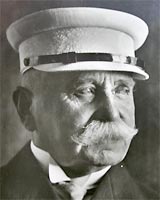 |
A man left his mark on this city, Count Ferdinand von Zeppelin (1838-1917). This inventor, visionary and entrepreneur, sought to prevent aircraft from 1874. His airships were the starting point for building complete industrial branches. The Dornier aircraft, the Maybach engines, ZF gears are born thanks to the construction of airships. The founding companies were associates and companions of the Earl, who wrote a key chapter in the history of aviation and I'industrie. In 1895, he filed a patent including the main features of dirigibles (rigid aluminum skeleton - Designated for gas content in many cylindrical cells - ...) but about the lack of interest in the Committee of Experts, he is obliged finance by itself the realization of this idea. Thus, July 2, 1900, Count Zeppelin flew aboard a rigid airship of his invention over Lake Constance (Bodensee).The balloon of 128m in length, called LZ1, range 6 kilometers in 18 minutes at an altitude of 400 m and then joined its floating hangar on Lake Constance, where it had been built to allow the airship to fly upwind. |
The 17 small balloons of LZ1 contained 11,300 m3 of hydrogen and two pods each carrying a 15 hp engine gave it a speed of 29 km. More than one million DM were spent for the construction of this first Zeppelin. If the flights of the aircraft above the Bodensee were rewarded with a decoration of the Red Eagle, the count was particularly need a contract. The King of Württemberg granted him to launch a lottery. The newspapers published subscriptions. From 1900 to 1937, 119 airships come out of the factory in Friedrichshafen. The rigid airships are different types of flexible because they use an outer aerodynamic mounted on a rigid structure with several separate balloons containing a gas lighter than air hydrogen or helium. With his collaborators, Count Zeppelin established the foundations of international air traffic that he does not know. He died in Berlin at the age of 79 years. His funeral in Stuttgart was a great celebration. Throughout the world, his name is still synonymous with the fascination and attraction exerted on men by airships. |
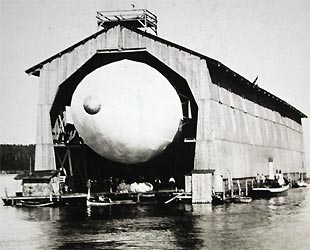 |
The Graf Zeppelin - global success 1928 - 1939 |
|
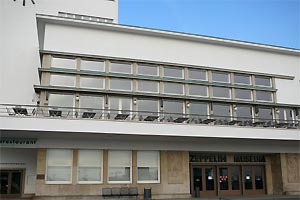 |
||
The museum offers a total exhibition area of 4000 square meters, where you can admire the most significant collection of the history of world aviation. It is housed in several rooms.Some items are used on board, such as dishes, menus .. One of these rooms is dedicated to engines, another traces the lives of men who have contributed to this great adventure: Graf Zeppelin, Alferd Colsman Hugo Eckener, Ludwig Durr, Alfred Graf von Soden-Fraunhofen, Karl Maybach, and Claude Dornier. We can also see the tip of the Hindenburg with its docking system. |
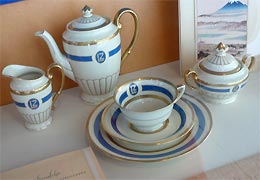 |
|
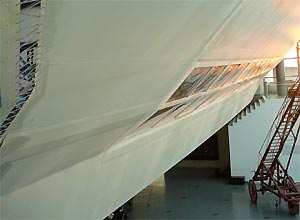 |
The reconstruction (scale 1) of part of the LZ 129, true to the original long and 33 meters is the highlight of our visit. During its first test flight on March 4, 1936, the airship had not been named yet. The next day, flying to Munich, that Dr. Eckener had called "Hindenburg". This earned him to be convened by Dr. Goebbels (Propaganda Minister): "It gives not the name of an old man of the old regime to the establishment of the new reich" The exterior canvas is formed by spindles of cotton cloth, laced on the main fault. They are coated with an exterior varnish providing protection against the rain. Furthermore the outer face of the canvas, silver color reflects the sun's heat, while the inside is painted red to protect against ultraviolet rays. We climb aboard a boarding ladder to get inside what the LZ129. We thus discover the top, the bridge "A" with the rooms and passenger cabins. |
You can get an overview of the aménagment these areas and part restored in the museum by clicking on this button: |
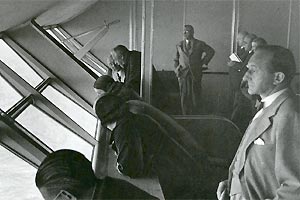 On board the Hindenburg |
The rooms reserved for passengers are reconstructed and furnished in authentic style of the time it is a real illusion of time travel by zeppelin. Indeed, the passenger large zeppelins once full advantage of the incredible sensation of floating silently in the air near the ground and in an atmosphere of style and luxury. We stroll the lounge from the promenade deck overlooking large windows that allow passengers to watch continents and oceans. The Hindenburg had more luxurious facilities for passengers than others airship. |
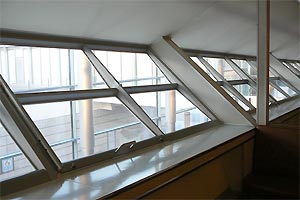 On board of the Museum |
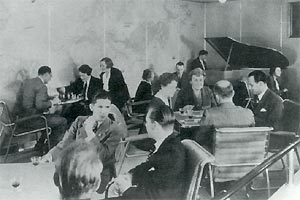 |
Instead of being in a gondola under the airship, they had been built on two decks inside the hull. The spacious lounge is equipped with chairs and tables aluminum making them extremely lightweight. At the end of the promenade deck, next to the living room is a room dedicated to reading and writing. |
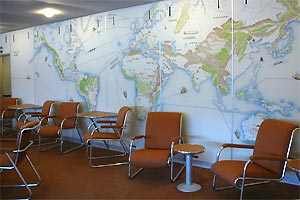 |
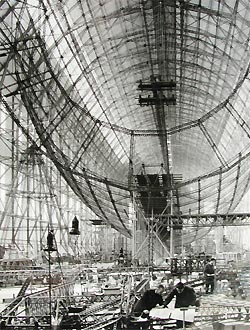 |
Some details about the manufacture of Zeppelins: The shape of the hull is obtained by means of a metal frame with outriggers, couples and braces. All the elements are in light alloy assembled by riveting. On this frame is stretched a fabric exterior. The nacelles, empennage and control surfaces are connected rigidly to the frame that contains the balloon inflated carrier gas (hydrogen or helium). |
|
The structure of Zeppelins has evolved over the years but since 1916, their design has not changed significantly. The keel using row movement for the personnel to contain the ballast bags with a capacity of 500 to 1000 liters, fuel tanks, access to the engine nacelles, the position of crew rest. The tailplane of the Zeppelins are cruciform shape. Their structure is the same type of construction than the keel. To the Hindenburg, a cockpit emergency to direct orders is located in the lower vertical tail. As the last airship, the LZ129 was fitted to the front tip of a mechanical assembly for mooring the balloon vertical mast attached to the ground. The balloon could be moored and remaining always oriented upwind. |
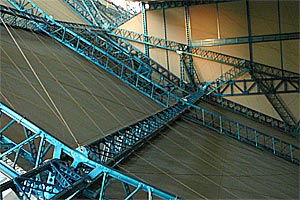 |
|
Halls of the museum tell the saga of Zeppelins and other airships, with glass cases containing models, clothing, utilitarian objects and used on airships. There are even items that burned from the fire of LZ129. |
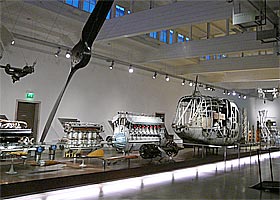 |
One room is devoted to engines. Wilhelm Maybach joined in 1907 with Ferdinand von Zeppelin to develop engines for airships.
All Zeppelin airships (LZ9 until the Graf Zeppelin) will be equipped with the exclusive Maybach engines. But the Treaty of Versailles prohibited Germany after the war, the manufacture of airships. Maybach turned to the automobile. On the Graf Zeppelin, the engines were powered by a combustible gas, whose density was similar to that of air. The gas was contained in the balloon lodged in the hull under the Hydrogen Balloon. |
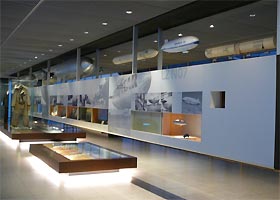 |
This mode power engines can navigate to constant weight without having to maintain static equilibrium, the evacuation of hydrogen to compensate for load shedding due to the consumption of fuel. But the Hindenburg, scheduled to be inflated Helium was equipped with diesel engines. It included a few balloons with hydrogen to a gas valve less costly and rare helium. In the accident which ended his short career he was filled with hydrogen, having failed to supply some 120 000 m3 of helium required for its swelling. |
 |
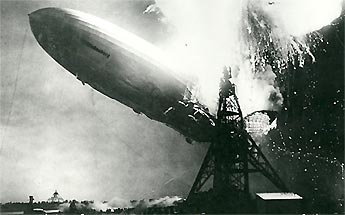 |
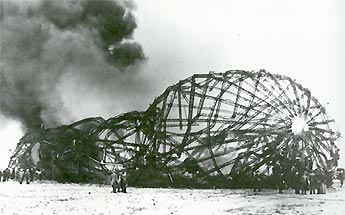 |
"At its 63rd passage, May 6, 1937, when the cable or junction with the mooring mast at Lakehurst touched the ground, the balloon caught fire from behind and from above. The fire spread, took another the masssive height, and then fell down. This tragedy resulted in the deaths of 35 people.There were 62 survivors, including several absolutely unharmed, surprising figure when we see photographs of the disaster. 22 crew, 12 passengers and one man team of land are dead. Captain Pruss was seriously injured. Captain Lehmann, remained on board for duty, was fatally burned. The cause of the Hindenburg Disaster was always controversial. |
|
|
|
Thousands of people witnessed the accident which put an abrupt end to one of the symbols of the German Reich. The aluminum casing of the Hindenburg, disassembled and shipped by truck to Perth Amboy, was cast in Germany and used in the manufacture of German planes during the Second World War. |
|
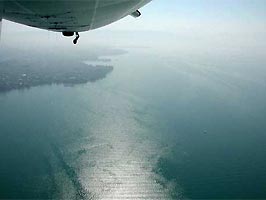 |
Today, the DZR offers commercial channels on the Zeppelin NT, departing from Friedrichshafen to fly over Lake Constance (the route of flight depends on weather conditions) or excursions to Stuttgart and Berlin. The Zeppelin NT is now the largest airship in operation. But the flights are mid-April to mid-October. Then we come back. In addition to the circuit with the Zeppelin NT we can also visit the hangar assembly. For a flight of 30 minutes, must still count per person. : 200 € , but ..... we take ourselves to dream that we are, too, for a moment of privileged passengers Zeppelin |
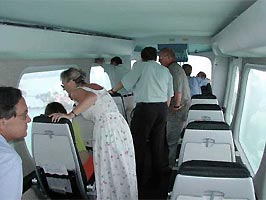 |
Crédit photo : Zeppelin NT |
Crédit photo : Zeppelin NT |
 |
But it begins to be a little late and we must find a room for the night. We move away very little from the center of Friedrichshafen We are greeted warmly in the Landhaus Monika, home of traditional rural design in a small village, quiet Meckenbeuren-Buch (only 10km from Friedrichshafen). After a night swarmed by airships, we take a real German breakfast . If you just visit the museum, do not hesitate to spend a night with Monika: http://www.landhaus-monika.com/ |